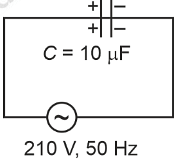A 10 µF capacitor is connected to a 210 V, 50 Hz source as shown in figure. The peak current in the circuit is nearly (π = 3.14) :
 :
:
 :
:- 0.58 A
- 0.93 A
- 1.20 A
0.35 A
The Correct Option is B
Approach Solution - 1
Capacitive Reactance
$$ X_C = \frac{1}{\omega C} = \frac{1}{2 \pi f C} $$
$$ X_C = \frac{1}{2 \times 3.14 \times 50 \times 10 \times 10^{-6}} = \frac{1000}{3.14} $$
$$ V_{rms} = 210 \ V $$
$$ i_{rms} = \frac{V_{rms}}{X_c} = \frac{210}{X_c} $$
Peak current \( = \sqrt{2} i_{rms} \)
$$ = \sqrt{2} \times \frac{210}{1000} \times 3.14 = 0.932 \simeq 0.93 \ A $$
Approach Solution -2
Step 1: Recall the Formula for Capacitive Reactance
The capacitive reactance is given by:
$$ X_C = \frac{1}{2\pi f C} $$
Given values:
- \( f = 50 \) Hz
- \( C = 10 \mu F = 10 \times 10^{-6} \) F
Step 2: Calculate \( X_C \)
$$ X_C = \frac{1}{2\pi (50) (10 \times 10^{-6})} $$
Solving:
$$ X_C = \frac{1}{3.14 \times 10^{-3}} $$
$$ X_C \approx 318.47 \, \Omega $$
Step 3: Calculate the Peak Current
The peak current is given by:
$$ I_0 = \frac{V_0}{X_C} $$
Where:
$$ V_0 = \sqrt{2} V_{\text{rms}} = \sqrt{2} (210) $$
$$ V_0 \approx 296.98 \text{ V} $$
Substituting values:
$$ I_0 = \frac{296.98}{318.47} $$
$$ I_0 \approx 0.93 \text{ A} $$
Step 4: Conclusion
The peak current is approximately 0.93 A.
Top Questions on Capacitors and Capacitance
- A capacitor is charged by a battery to a potential difference \( V \). It is disconnected from the battery and connected across another identical uncharged capacitor. Calculate the ratio of total energy stored in the combination to the initial energy stored in the capacitor.
- CBSE CLASS XII - 2025
- Physics
- Capacitors and Capacitance
- “There is a limit to the amount of charge that can be stored on a given capacitor.” Explain.
- CBSE CLASS XII - 2025
- Physics
- Capacitors and Capacitance
- The plates of a parallel plate capacitor are separated by d. Two slabs of different dielectric constant \(K_1\) and \(K_2\) with thickness \(d/2\) and \(d/2\) respectively are inserted in the capacitor. Due to this, the capacitance becomes two times larger than when there is nothing between the plates. If \(K_1 = 1.25 K_2\), the value of \(K_2\) is :
- NEET (UG) - 2025
- Physics
- Capacitors and Capacitance
- Two capacitors $ C_1 = 4\mu F $ and $ C_2 = 6\mu F $ are connected in series across a 60 V battery. The potential difference across $ C_2 $ is:
- BITSAT - 2025
- Physics
- Capacitors and Capacitance
- A parallel plate capacitor of capacitance 1 μF is charged to a potential difference of 20 V. The distance between plates is 1 μm. The energy density between the plates of the capacitor is:
- JEE Main - 2025
- Physics
- Capacitors and Capacitance
Questions Asked in NEET exam
- A microscope has an objective of focal length \(f_o = 2\) cm and an eyepiece of focal length \(f_e = 4\) cm. The tube length of the microscope is \(L = 40\) cm. If the distance of distinct vision of eye is \(D = 25\) cm, the magnification in the microscope is:
- NEET (UG) - 2025
- Optical Instruments
- Which one of the following is an example of ex-situ conservation?
- NEET (UG) - 2025
- Ex-Situ Conservation
- Which one of the following compounds can exist as cis-trans isomers?
- NEET (UG) - 2025
- Organic Chemistry
- Who proposed that the genetic code for amino acids should be made up of three nucleotides?
- NEET (UG) - 2025
- Molecular Biology
- An electron (mass \(9 \times 10^{-31}\) kg and charge \(1.6 \times 10^{-19}\) C) moving with speed \(c/100\) (\(c\) = speed of light) is injected into a magnetic field of magnitude \(9 \times 10^{-4}\) T perpendicular to its direction of motion. We wish to apply a uniform electric field \( \vec{E} \) together with the magnetic field so that the electron does not deflect from its path. (speed of light \(c = 3 \times 10^8\) m/s):
- NEET (UG) - 2025
- Electric Field